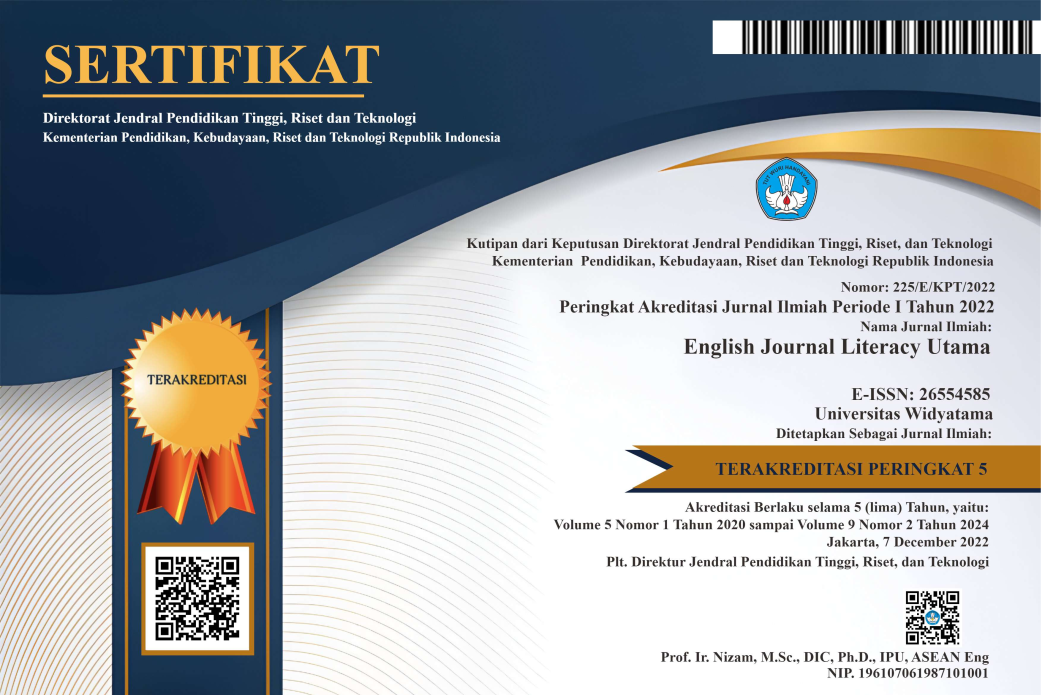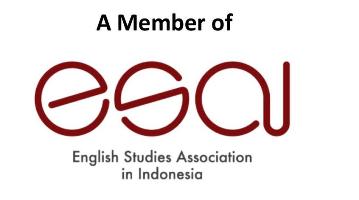Conceptual Metaphors in The Little Mermaid: Cognitive Semantic Analysis
DOI:
https://doi.org/10.33197/ejlutama.v7i1.163Keywords:
conceptual metaphor, The Little Mermaid Fairy Tale, cognitive semanticsAbstract
This study describes the embodiment of conceptual metaphors and image schemes according to Cruse and Croft (2004) in the fairy tale The Little Mermaid by Hans Christian Andersen. The approach used in this research is descriptive qualitative as a methodological approach and a cognitive semantic approach as a theoretical approach. The use of figurative language is widely used in writing to add to the impression, emphasis, and beautify an expression outlined by the author, one of which is in a fairy tale. Based on the results of the research that has been carried out, there are 14 pieces of metaphor conceptualization data found which are included in the type; (1) anthropomorphic, namely metaphors that refer to inanimate objects carried out by diverting or moving from the human body or its parts, from the meaning or values and desires possessed by humans, (2) sineaesthetic metaphors, namely metaphors based on transfer from one sense to another, (3) concrete to abstract metaphors, namely metaphors that describe concrete experiences to abstract things, and (4) animal metaphors, namely metaphors that use animals or animal body parts or something related to animals to imagery of something else and three types of image schemas namely existence schemas (existence ), which consists of Removal, Bounded Space, Cycle, Object, Process , the scheme of power ( force ) consisting of Balance, Counterforce, Compulsion, Restraint, Enablement, Blockage, Diversion, Attraction , schemes and unity ( Unity / Multiplicity) comprising from Merging, Collection, Splitting, Iteration, Part-Whole, Mass-Count, Link.
References
Chaer, Abdul. (1995). Introduction to Indonesian Semantics. Jakarta: Rineka Cipta.
Cruse, DA, & Croft, W. (2004). Cognitive Linguistics. Cambridge: Cambridge University Press.
Dessiliona & Nur. (2018). Conceptual Metaphor in the Lyrics of the Band's Revolverheld Album In Farbe.Sawerigading. (24)2, 178.
Keraf, Gorys. (1997). Composition. Jakarta: Eternal Independent Pledge.
Lakoff, George and Johnson, Mark. (2003), Metaphors We Live by Chicago: The University of Chicago Press.
Leech, Geoffrey. (1981). The Study of Meaning. Middlesex: Penguin Books.
Moleong, Lexy J. (2017). Qualitative Research Methods, 36th printing, Bandung: PT. Teen Rosdakarya Offset.
Sirait, A. Indrayani, LM. Amalia, RM. Lingga, TR. (2022). Conceptualizations and Schematizations Of Head Metaphors: A Conceptual Metaphor Theory. ELTIN JOURNAL: Journal of English Language Teaching in Indonesia Vol 10 No 1.
Sugiyono. (2016). Research Methods, Quantitative, Qualitative, and R&D. 23rd edition. Bandung: Alphabeta.
Syah, I., Wagiati, W., & Darmayanti, N. (2020). Metafora Konseptual Cinta Dalam Lirik Lagu Taylor Swift Album Red: Kajian Semantik Kognitif (Conceptual Metaphor of Love in Taylor Swift Songs Album of Red: a Cognitive Semantics Approach). Metalingua: Jurnal Penelitian Bahasa, 18(1), 47-58.
Ullman, Stephen, 2012. Introduction to Semantics. Adapted by Sumarsono of Semantics, An Introduction to The Science of Meaning. Yogyakarta: Student Library.
Downloads
Published
Issue
Section
License
Copyright (c) 2022 Jasmine Nadira Awwali, Tajudin Nur

This work is licensed under a Creative Commons Attribution-NonCommercial-ShareAlike 4.0 International License.
Creative Commons Attribution-ShareAlike 4.0 International License



















